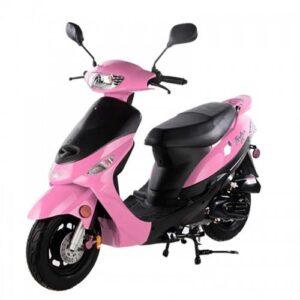
How to Properly Perform Maintenance on a 50cc Scooter
Q9powersportsusa.com StaffShare
Performing routine maintenance on a 50cc scooter
Regular maintenance is essential to keep your 50cc scooter running smoothly and ensure its longevity. By following a few simple steps, you can prevent breakdowns, extend the life of your scooter, and save money on costly repairs. In this article, we will guide you through the process of properly maintaining your 50cc scooter.
Step 1: Check Fluid Levels
Start by checking the fluid levels, including the engine oil, transmission fluid, and brake fluid. Refer to your scooter's manual to locate the appropriate dipsticks and fill lines. Ensure that all fluids are at the recommended levels. If any fluids are low, top them up using the manufacturer-recommended fluids.
Step 2: Inspect and Clean Air Filter
The air filter prevents dust and debris from entering the engine, ensuring optimal performance. Remove the air filter cover and inspect the filter. If it appears dirty or clogged, clean it with compressed air or replace it if necessary. A clean air filter will improve fuel efficiency and overall performance.
Step 3: Check Spark Plug
The spark plug plays a crucial role in the ignition process. Remove the spark plug using a spark plug wrench and inspect its condition. If the electrode is worn or covered in carbon deposits, replace the spark plug. A well-maintained spark plug ensures smooth engine operation and efficient fuel combustion.
Step 4: Inspect Tires
Regularly inspect the tires for wear and tear, and ensure they are properly inflated. Underinflated or worn-out tires can affect handling and fuel efficiency. Use a tire pressure gauge to check the tire pressure and refer to the manufacturer's guidelines for the recommended pressure.
Step 5: Lubricate Moving Parts
To keep the scooter running smoothly, lubricate the moving parts such as the throttle cable, brake cables, and chain. Use a high-quality lubricant recommended by the manufacturer. Proper lubrication reduces friction, prevents rust, and extends the lifespan of these components.
Step 6: Check Brakes
Brakes are crucial for your safety, so it's important to regularly inspect and maintain them. Check the brake pads for wear and replace them if necessary. Ensure the brake cables are properly adjusted and the brake fluid is at the recommended level. Test the brakes before every ride to ensure they are functioning correctly.
Step 7: Clean and Wax
Keeping your scooter's exterior clean not only enhances its appearance but also protects it from corrosion. Use a mild detergent and water to clean the body, and then apply a coat of wax to protect the paint. Regular cleaning and waxing will keep your scooter looking new and help preserve its resale value.
Step 8: Check Battery
The battery is essential for starting your scooter and powering the electrical components. Regularly check the battery's voltage using a multimeter. If the voltage is low or the battery is old, consider replacing it. Clean the battery terminals and ensure they are tight and free from corrosion.
Step 9: Inspect the Drive Belt
The drive belt is responsible for transferring power from the engine to the wheels. Inspect the drive belt for wear, cracks, or fraying. If you notice any signs of damage, replace the drive belt to maintain proper power transmission and prevent belt failure while riding.
Step 10: Check Lights and Signals
Ensure that all lights and signals on your scooter are in proper working condition. Test the headlights, brake lights, turn signals, and horn regularly. Replace any burnt-out bulbs or faulty components to ensure your safety and visibility on the road.
Step 11: Inspect the Exhaust System
Regularly inspect the exhaust system for any signs of damage or leaks. A damaged exhaust can affect engine performance and increase noise levels. If you notice any issues, have a professional inspect and repair the exhaust system.
Step 12: Maintain a Clean Fuel System
Over time, debris and impurities can accumulate in the fuel system, affecting performance. Use a fuel system cleaner recommended by the manufacturer to keep the fuel system clean. Additionally, ensure that you use high-quality fuel to prevent fuel-related issues.
Step 13: Check Suspension and Steering
Regularly inspect the suspension system and steering components for any signs of wear or damage. Check for loose bolts, worn-out bushings, or leaking shocks. Proper suspension and steering ensure smooth and stable handling, enhancing your riding experience.
Step 14: Inspect the Cooling System
If your 50cc scooter is liquid-cooled, it's essential to check the cooling system regularly. Inspect the radiator for debris or clogs, and clean it if necessary. Ensure that the coolant level is at the recommended level. If the coolant is dirty or old, flush and replace it according to the manufacturer's instructions.
Step 15: Keep a Maintenance Log
Maintaining a log of all your maintenance activities is a good practice. Note down the date, mileage, and details of each maintenance task you perform. This log will help you keep track of when specific maintenance tasks were last completed and when they are due next.
Conclusion
Proper maintenance of your 50cc Motor scooter is essential for its optimal performance and longevity. By following these steps and staying consistent with your maintenance routine, you can enjoy a reliable and efficient ride. Remember to consult your scooter's manual for specific maintenance requirements and intervals. With proper care, your 50cc scooter will continue to provide you with years of enjoyable transportation.
